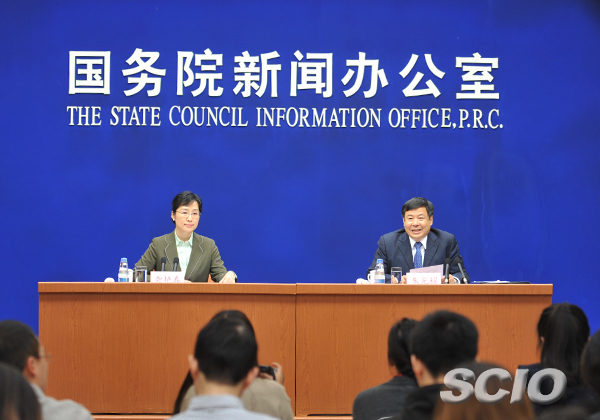SCIO briefing on economic outcomes achieved during China-US presidential meeting in Beijing
A press conference was held to introduce the economic outcomes achieved during the China-U.S. presidential meeting.
Speaker:
Mr. Zhu Guangyao, vice minister of the Ministry of Finance
Chair:
Xi Yanchun, vice director-general of the Press Bureau, State Council Information Office
Date:
Nov. 10, 2017

Xi Yanchun:
Ladies and gentlemen, good afternoon. Welcome to this press conference. Today, we are delighted to have with us Mr. Zhu Guangyao, vice minister of the Ministry of Finance.
He will introduce the economic outcomes achieved during the China-U.S. presidential meeting in Beijing, and answer some of your questions.
Now, I give the floor to Mr. Zhu.
Zhu Guangyao:
President Xi Jinping and U.S. President Donald Trump held in-depth talks on Nov. 8 and 9 during the latter's first state visit to China. President Trump is the first head of state received by President Xi since the 19th National Congress of the Communist Party of China (CPC) last month. An important consensus was reached during the successful and historic presidential meeting, charting the course and drawing up a blueprint for the sound and sustained development of Sino-U.S. relations in the coming decades.
President Xi said during the meeting that China-U.S. economic ties were mutually beneficial and covered a wide range of fields including the macro-economy, trade, investment and international economic cooperation. Continued stable development of these ties will not only be of benefit to the two peoples, but also be a major contributor to global growth. China and the United States should face all economic issues in a forward-looking and constructive way and resolve problems by expanding economic cooperation. President Donald Trump expressed agreement with these views.
China and the United States have maintained close coordination on financial, currency and exchange rate policies, as well as structural reforms and global economic governance. The two countries will work together to promote robust, sustainable, balanced and inclusive growth of the global economy. As well, both sides will encourage their aviation regulators to sign the Implementation Procedures for Airworthiness under the Bilateral Aviation Safety Agreement.
As an effort to implement the plans on opening the country wider to the outside world set out during 19th CPC National Congress, China has made the following decisions: to ease the proportion limitations on single or multiple foreign direct or indirect investment converted into securities, funding management and futures corporate structural establishment to 51 percent pending removal of the limit in three years' time; to lift the proportion restrictions of no more than 20 percent and 25 percent on foreign single and joint shareholding respectively in Chinese banks and financial capital management companies, and impose equal proportion restrictions on bank equity for Chinese and foreign investors; to lessen the proportion limit to 51 percent on single or multiple foreign investment into life insurance companies in three years' time and to lift the limit entirely in five years; to make a moderate reduction in car import tariffs in a gradual manner, and to launch trials on lifting the proportion limits on foreign shareholdings in special-purpose and new energy vehicle companies in pilot free trade zones before June, 2018; to implement the same value-added tax (VAT) policy on imported and domestic dried distiller grains (DDGS) and remove VAT on imported DDGS.
China urges the United States to relax its export controls on high-tech products, fulfill its obligations under Article 15 of the Protocol on China's Accession to the World Trade Organization (WTO), give fair treatment to Chinese enterprises investing in the United States, facilitate China International Capital Corporation's independent application for offering financial services in the United States and take a prudent attitude towards trade remedial measures. Both sides will maintain communications on one-year and medium-to-long term economic cooperation plans.
The two countries signed business deals and bilateral investment agreements worth $250 billion during President Trump's visit to China. That's all I want to share with you on the economic outcomes achieved during the China-U.S. presidential meeting in Beijing.
Now, I am ready to take your questions.

